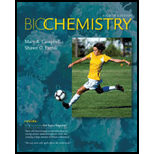
Concept explainers
RECALL What are the two primary molecules that link anabolic and catabolic reactions?
Interpretation:
The two primary molecules that link the anabolic and catabolic pathways are to be named.
Concept introduction:
Anabolic pathway is the process that require energy to synthesize the large molecules from simple molecules.
Catabolic pathway is the process that breaks down large molecules into smaller molecules.
Anabolic and catabolic pathways are both opposite to each other.
Answer to Problem 1RE
Solution: ATP and NADPH are the two primary molecules that link anabolic and catabolic pathways. Light energy is used by plants to make ATP and NADH, which are further used to make carbohydrate compounds. These carbohydrates are the source of energy for other organisms.
Explanation of Solution
All the metabolisms are linked to photosynthesis in one way or another. ATP and NADH are the two very important molecules that link all the metabolism pathways. ATP is the currency of energy, which is able to store and transfer energy within the cells. NADH, nicotinamide adenine dinucleotide, is a form of coenzyme found in all organism.
ATP and NADH both are forms of energy.
Want to see more full solutions like this?
Chapter 24 Solutions
Biochemistry
- Which type of enzyme catalyses the following reaction? oxidoreductase, transferase, hydrolase, lyase, isomerase, or ligase.arrow_forward+NH+ CO₂ +P H₂N + ATP H₂N NH₂ +ADParrow_forwardWhich type of enzyme catalyses the following reaction? oxidoreductase, transferase, hydrolase, lyase, isomerase, or ligase.arrow_forward
- Which features of the curves in Figure 30-2 indicates that the enzyme is not consumed in the overall reaction? ES is lower in energy that E + S and EP is lower in energy than E + P. What does this tell you about the stability of ES versus E + S and EP versus E + P.arrow_forwardLooking at the figure 30-5 what intermolecular forces are present between the substrate and the enzyme and the substrate and cofactors.arrow_forwardprovide short answers to the followings Urgent!arrow_forward
- Pyruvate is accepted into the TCA cycle by a “feeder” reaction using the pyruvatedehydrogenase complex, resulting in acetyl-CoA and CO2. Provide a full mechanismfor this reaction utilizing the TPP cofactor. Include the roles of all cofactors.arrow_forwardB- Vitamins are converted readily into important metabolic cofactors. Deficiency inany one of them has serious side effects. a. The disease beriberi results from a vitamin B 1 (Thiamine) deficiency and ischaracterized by cardiac and neurological symptoms. One key diagnostic forthis disease is an increased level of pyruvate and α-ketoglutarate in thebloodstream. How does this vitamin deficiency lead to increased serumlevels of these factors? b. What would you expect the effect on the TCA intermediates for a patientsuffering from vitamin B 5 deficiency? c. What would you expect the effect on the TCA intermediates for a patientsuffering from vitamin B 2 /B 3 deficiency?arrow_forwardDraw the Krebs Cycle and show the entry points for the amino acids Alanine,Glutamic Acid, Asparagine, and Valine into the Krebs Cycle - (Draw the Mechanism). How many rounds of Krebs will be required to waste all Carbons of Glutamic Acidas CO2?arrow_forward
 BiochemistryBiochemistryISBN:9781305961135Author:Mary K. Campbell, Shawn O. Farrell, Owen M. McDougalPublisher:Cengage Learning
BiochemistryBiochemistryISBN:9781305961135Author:Mary K. Campbell, Shawn O. Farrell, Owen M. McDougalPublisher:Cengage Learning
